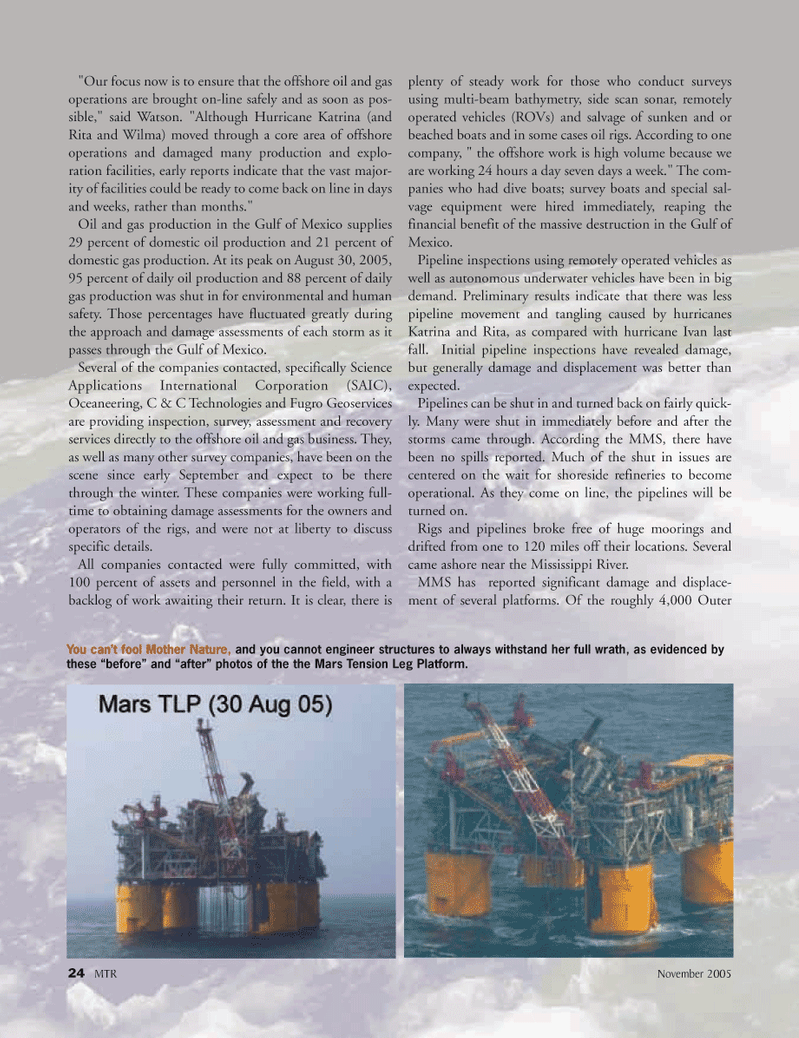
Page 24: of Marine Technology Magazine (November 2005)
Seafloor Engineering
Read this page in Pdf, Flash or Html5 edition of November 2005 Marine Technology Magazine
24 MTR November 2005 "Our focus now is to ensure that the offshore oil and gas operations are brought on-line safely and as soon as pos- sible," said Watson. "Although Hurricane Katrina (and
Rita and Wilma) moved through a core area of offshore operations and damaged many production and explo- ration facilities, early reports indicate that the vast major- ity of facilities could be ready to come back on line in days and weeks, rather than months."
Oil and gas production in the Gulf of Mexico supplies 29 percent of domestic oil production and 21 percent of domestic gas production. At its peak on August 30, 2005, 95 percent of daily oil production and 88 percent of daily gas production was shut in for environmental and human safety. Those percentages have fluctuated greatly during the approach and damage assessments of each storm as it passes through the Gulf of Mexico.
Several of the companies contacted, specifically Science
Applications International Corporation (SAIC),
Oceaneering, C & C Technologies and Fugro Geoservices are providing inspection, survey, assessment and recovery services directly to the offshore oil and gas business. They, as well as many other survey companies, have been on the scene since early September and expect to be there through the winter. These companies were working full- time to obtaining damage assessments for the owners and operators of the rigs, and were not at liberty to discuss specific details.
All companies contacted were fully committed, with 100 percent of assets and personnel in the field, with a backlog of work awaiting their return. It is clear, there is plenty of steady work for those who conduct surveys using multi-beam bathymetry, side scan sonar, remotely operated vehicles (ROVs) and salvage of sunken and or beached boats and in some cases oil rigs. According to one company, " the offshore work is high volume because we are working 24 hours a day seven days a week." The com- panies who had dive boats; survey boats and special sal- vage equipment were hired immediately, reaping the financial benefit of the massive destruction in the Gulf of
Mexico.
Pipeline inspections using remotely operated vehicles as well as autonomous underwater vehicles have been in big demand. Preliminary results indicate that there was less pipeline movement and tangling caused by hurricanes
Katrina and Rita, as compared with hurricane Ivan last fall. Initial pipeline inspections have revealed damage, but generally damage and displacement was better than expected.
Pipelines can be shut in and turned back on fairly quick- ly. Many were shut in immediately before and after the storms came through. According the MMS, there have been no spills reported. Much of the shut in issues are centered on the wait for shoreside refineries to become operational. As they come on line, the pipelines will be turned on.
Rigs and pipelines broke free of huge moorings and drifted from one to 120 miles off their locations. Several came ashore near the Mississippi River.
MMS has reported significant damage and displace- ment of several platforms. Of the roughly 4,000 Outer
You can’t fool Mother Nature, and you cannot engineer structures to always withstand her full wrath, as evidenced by these “before” and “after” photos of the the Mars Tension Leg Platform.
MTR#3 (17-32).qxd 11/14/2005 12:59 PM Page 24

 23
23

 25
25
